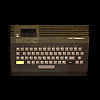Thomson computers

In the 1980s the French Thomson company produced a range of 8-bit computers based on the 6809E CPU.[1]
They were released in several variations (mostly concerning the keyboard or color of the casing) covering the MO and TO series[2] from late 1982 to 1989. While MO and TO models are incompatible in software, most of the peripherals and hardware were compatible.
These machines were common in France due to the 1980s governmental educational program Computing for All (Informatique pour Tous). Around 100,000 MO5 and TO7/70 computers were ordered and installed in schools.[3] Export attempts to Germany, Italy, Algeria, USSR, India, Argentina and Spain were unsuccessful. By 1988 Thomson only sells 60,000 of the predicted 150,000 computers, abandoning computer development the following year.[3]
First generation[]
- : released in 1983, it was a Motorola 68000-based machine running Unix v7.[4]
- Thomson MO5: released in 1984[5] in order to honor the "Plan Informatique pour Tous".[6] Supplied with 48K RAM (32K available to user in Basic 1.0) and first released with a rubber keyboard. Later it featured a mechanical keyboard. It was edited in a limited edition with a white casing, named "MO5 Michel Platini".
- Thomson TO7: produced from 1982 to 1984. Supplied with 24K RAM (16K used by the video) and upgradable to 48K. 8 color display.[7]
- Thomson TO7/70: 1984 version with more RAM (64K, upgradable into 128K) and 16 color display.[8]
- Thomson MO5E: 1985 export version, with a different casing featuring a mechanical keyboard, a parallel port, two joystick ports, an internal PAL modulator and an integrated power supply.
Second generation[]
- Thomson TO9 : released in late 1985. Separate keyboard and central unit, 128K RAM and a 3½-inch floppy disk drive.[9]
- Thomson MO5NR: released in 1985-1986. This is a MO6 in a MO5E casing, with an integrated network interface controller, the nanoréseau (nano network), which was used in French schools.
- Thomson TO16 (prototype): prototype developed in 1985-1988.
- Thomson MO6 : Released in 1986. 128K RAM and built in tape recorder.[10]
- Olivetti Prodest PC128 : Same as Thomson MO6, were sold in Italy as Olivetti Prodest PC128.
- Thomson TO8 : released in late 1986. 256K RAM, 80K ROM with Microsoft Basic 512, extra video modes.[11]
- Thomson TO9+ : released in late 1986, Separate keyboard and central unit, 512K RAM with a built in modem and a 3½-inch floppy disk drive.[12]
- Thomson TO8D : released in late 1987, it was a TO8 with a 3½-inch floppy disk drive.
PC compatible[]
- Thomson TO16 : released in September 1987. 8088 based IBM compatible PC.[13]
| Wikimedia Commons has media related to Thomson computers. |
See also[]
- Microsoft Basic 1.0 - A version of BASIC used on Thomson computers
- Thomson EF936x - graphic chip used on Thomson computers
- Computing for All, a French government plan to introduce computers to the country's pupils
References[]
- ^ "OLD-COMPUTERS.COM : The Museum - Thomson". Archived from the original on 25 February 2021.
- ^ Thomson 8-bit computer emulation with MESS
- ^ a b "Thomson". www.obsolete-tears.com.
- ^ "OLD-COMPUTERS.COM : The Museum - Thomson Micromega32". www.old-computers.com.
- ^ Thomson MO5 MESS driver
- ^ Wolf, Mark J. P. (May 27, 2015). Video Games Around the World. MIT Press. ISBN 9780262527163 – via Google Books.
- ^ "Thomson TO7". www.obsolete-tears.com.
- ^ Thomson TO7/70 MESS driver
- ^ "Thomson TO9". www.obsolete-tears.com.
- ^ Thomson MO6 MESS driver
- ^ Thomson TO8 MESS driver
- ^ "Thomson TO9+". December 27, 2020.
- ^ "Thomson - TO16 PC". www.system-cfg.com.
External links[]
- Thomson computers
- Lists of computer hardware
- 6809-based home computers
- Computer companies of France
- Microcomputer stubs
